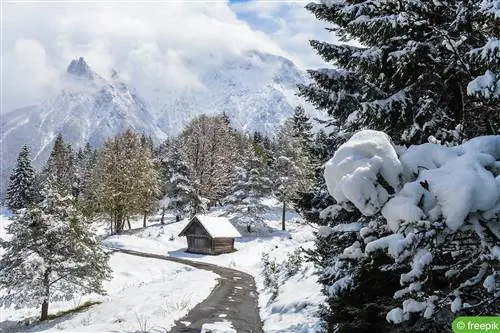- Author admin [email protected].
- Public 2023-12-17 03:39.
- Last modified 2025-01-24 12:45.
For some people it sounds like a longing dream: being able to retreat completely or at least on the weekends and on vacation to a really secluded hut. Far away from civilization with its hustle and bustle and its problems, not only close to nature, but right in the middle of it. A simple life, as shown by famous dropouts like Dick Proenneke. Of course, a lot of this is also possible in Central Europe. However, anyone who has such ideas still has to deal with many challenges and some limitations.
A cabin in the middle of nature
There are many basic things that you should think about beforehand and that you definitely need to find out before the adventure with the lonely cabin in the forest can start.
Property
Building your own dream cabin in the local nature is not that easy. In Germany you have to comply with numerous regulations that can massively restrict the construction project. This is clearly demonstrated by the availability of land on which you can build in the great outdoors. This is strictly limited, especially if you want to build a house in the forest. Even if you are a forest owner or have purchased a property far outside of a municipality, you must comply with outdoor laws. What is the outdoor area? According to§ 35(building in outdoor areas) of theGerman Building Code (BauGB), all land and areas that do not belong to the scope of qualified development plans are considered outdoor areas. They are located away from contiguous developments and are not permitted for the construction of a weekend or drop-out hut.
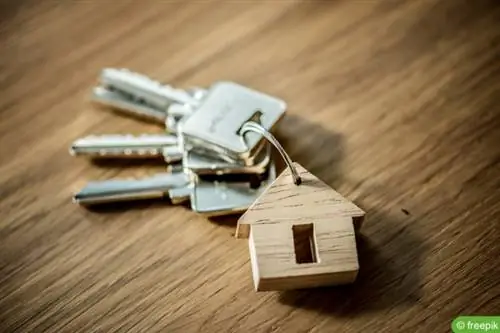
Exceptions
Only a few exceptions allow huts to be built outdoors:
- forestry companies
- agricultural businesses
- public utilities, such as electricity
- for research purposes
These are privileged building projects that can make use of the land. The outdoor area is not permitted for any construction projects that are used for recreation or living. This is intended to prevent the so-called “urban sprawl” of local forests and open spaces in order not to unnecessarily disturb flora, fauna and the natural soil conditions. A lonely hut can still be implemented in Germany if you decide on special areas. What does that mean? According to§ 10(special areas that serve recreational purposes) of theBuilding Use Ordinance (BauNVO), there are special areas that only allow dedicated construction projects. This means that you are only allowed to build very specific types of buildings there and use them accordingly. Special areas for recreation include the following:
- Weekend house area
- Holiday home area
- Camping area
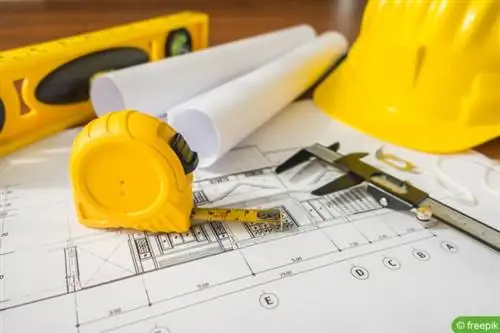
These are exactly the areas you need to look for if you want to build a private cabin far from civilization. They are usually provided in attractive and remote locations, which most closely corresponds to lonely living. These areas are always designated by the municipalities, which is something you must take into account. Despite the status as a special area, you still have to follow the municipality'sdevelopment plan so that there are no problems and perhaps even dismantling is necessary. The biggest disadvantage of the special areas is the proximity to possible neighbors. If that doesn't bother you, you are a little closer to your goal.
Note:
The dish huts typical of Baden-Württemberg may, as an exception, be built outdoors as long as they are not larger than 20 cubic meters. However, they are not suitable for living or vacationing, but only as storage space for tools or equipment on the property.
Weekend or holiday home?
When selecting a property for your dream cabin, the question often arises as to whether you should choose a holiday or weekend home area. This question can be answered quite easily, as the BauNVO provides concrete guidelines for the respective buildings within the areas. Holiday home areas are only permitted for construction projects that serve a “changing group of people”. To put it more simply: Cabins in a holiday home area are not primarily used for private purposes, but are rented out. In weekend house areas, however, exclusive use by the owner is intended. This means that family and friends are allowed to stay in the weekend house. Renting as a holiday home is not permitted in weekend home areas. This status brings with it special building regulations that you must observe:
- Building permit required
- Maximum height and floor area (differs in each federal state)
- usually no extensions allowed to prevent possible permanent living
- Mostly partially developed (specified by the municipality)
- Weekend house is considered a second home

It is important to follow the building regulations of each country. While in Lower Saxony a weekend house can have a maximum height of 3.2 meters and a floor area of 40 square meters, while in Bavaria up to 60 square meters are possible. There is no maximum height specified, only the house must not have a negative impact on the landscape. For this reason, the height is specified in the development plan of the respective special area. When it comes to development, you also need to check the regulations in the municipality. Water and sewage are often available, less often road access. Very few people have electricity and internet. Many communities attach great importance to ensuring that the special areas remain “picturesque”. For this reason, for example, power connections are omitted in order to avoid visible cables.
Weekend house as a permanent residence?
More and more campers are living permanently at the campsite. This is exactly what many cabin owners want, who want to completely distance themselves from the hustle and bustle of cities and towns. However, this is not possible in Germany. Weekend and holiday homes are not permitted as permanent residence if they are built in the relevant special areas. Exceptions to this rule are only possible if one of the two cases applies:
- Exception for the hut already noted in the development plan
- Weekend house area will be converted into a residential area

If, for example, your cabin meets the requirements of the development plan, you could be in luck. Here it is important to find out about possible exceptions from the municipality beforehand. Since no mixed areas with special areas are permitted for recreation in Germany, you have to decide whether you want to say goodbye to the peace and quiet of the forest and fields in the future when it comes to weekend house areas that are being converted into residential areas.
Far off the beaten track
When building a weekend house, you often face a major problem: transporting the building materials and the necessary equipment and machines. Depending on the property within the weekend home area, there is no proper road access. If this is the case, you will need to think carefully about how you will transport the materials to the property. The accessibility of the property also has a significant impact on the type of hut possible. For example, if the desired property is located on a lake and can only be reached by boat, obtaining materials will be difficult. There is also the problem that there is no direct address for many of the properties. If you commission a company to do the construction, you will have to switch to different access data:
- Notes about the location on the site plan
- Geocoding
- put markers on maps independently
If the property does not have a direct address, the location for construction companies or deliveries can be determined in this way. With these obstacles, precise planning is essential in order to build the hut. Of course, this is also the charm of having your own hut to relax in. The absence of modern everyday life is reflected in the remoteness of the project.
Classic log cabin or ?
Should it be romantic, rustic or as simple as possible? When it comes to building your hut, you are literally spoiled for choice, as different materials and architectural styles are available to you. The ultimate classic is the wooden log house. This is a hut whose walls consist of wooden beams stacked on top of each other and is usually built on a foundation made of concrete or stones. Square beams or round planks made of robust wood are used, which are quite weatherproof:
- Pines (Pinus)
- Spruce (Picea)
- Larch (Larix)
- Douglas fir (Pseudotsuga menziesii)
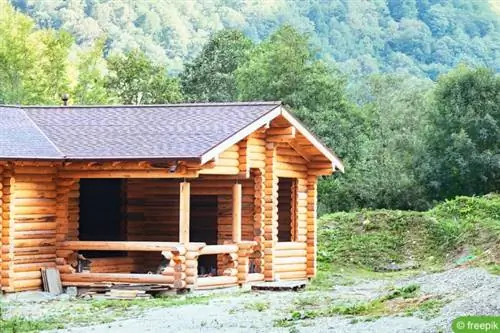
They have a very rustic style and are ideal for small to large properties in forests and fields. Log cabins are primarily built as one story. As a result, they usually fall under the regulations of the weekend house area.
Alternatives to the log house
In addition to the log cabin, there are other types of construction for your property:
- Finnhaus (roof-only house)
- Treehouse
- Barrel Hut
- Alpine hut (modified log cabin)
- Earth House
Earth houses are reminiscent at first glance of the hobbit houses from the work “The Lord of the Rings” by John R. R. Tolkien. They are built into existing hills to provide protection from the cold and the weather. Masonry is usually used for this, while the interior spaces are partitioned off with wood. This makes it possible to build a comfortable cabin on land that is not flat. Of course, you can use other materials to build a hut. These include:
- Bricks
- Natural stones
- Concrete
A popular alternative to a hut are construction trailers or so-called tiny houses. These are mini houses that are built on trailers and have complete equipment similar to a mobile home. Stylistically, they range from classic wooden houses to modern designs. The biggest advantage of the house on wheels: you don't need a foundation to use it. This reduces construction costs, for example, because you don't have to dig a pit or set point foundations. What you need is the following:
- Building permit
- Road access
- sufficiently level plot
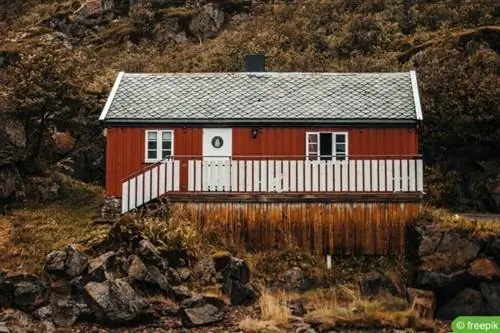
The building permit is particularly important. This is necessary because you park the construction trailer permanently, even if it is still on the trailer. From the moment the trailer is registered as a second home, it may no longer be moved away from the property. With a building permit you are on the safe side.
Note:
Insulation is essential when planning your hut in order to achieve effective temperature compensation. It can get very cold in the small houses, especially in the winter, which can be avoided.
Electricity, water, heating, internet and sewage in the lonely hut
Relaxing in the cottage is particularly easy when you have modern amenities at your disposal. The supply of electricity or sufficient heat in winter must be taken into account when planning a weekend house so that you don't freeze or have no water available for showering. You should include certain points in your planning:
Electricity
In addition to a power connection, which is not available on every weekend house property, the following methods of generating electricity are particularly suitable:
- Gasoline or diesel generators
- Gas Generator
- Photovoltaic system
- Emergency generator with battery
Diesel and gasoline generators produce large amounts of electricity, but they are very loud and not really environmentally friendly. Gas generators would be a better choice here, especially if you want to power devices such as a radiator. If you only need electricity for individual devices, you can use battery-powered emergency generators and fully charge them beforehand. The best thing: you can adjust the battery capacity according to the devices to be powered. This means the device runs optimally.
Especially recommended for electricity generation: a PV system. By using solar modules, energy can be generated permanently, which is then passed on to energy storage systems. Find out here why electricity storage is important for the effective use of PV electricity. The following properties are particularly important for use in the hut:
- Genset with inverter
- Solar modules compatible with aggregate
- Aggregate with various connection options (USB or 230 V socket)
Depending on the model, the solar modules can be installed on the roof or placed next to the hut. There are even modules that can be folded up and stored in the cabin when not needed. The modern solutions are ideal and cover the energy needs for vacation without any problem.
Water
Most properties in weekend house areas have a water connection. This can be found out from the community. The development plan also specifies whether development is necessary for the water connection. If you do not have access to water, you will need to collect water or provide it yourself during your stay. The following methods are available for this:
- Cistern (rainwater system)
- Water tank or water truck
- Canister with water
If you use the weekend house regularly, there are cisterns to collect rainwater. It is important for these that the water is treated before use and professionally passed on to the devices. This way you get enough domestic water. Drinking water is not available because cistern water is not suitable for human consumption. For this reason, you must make sure to bring your own drinking water.
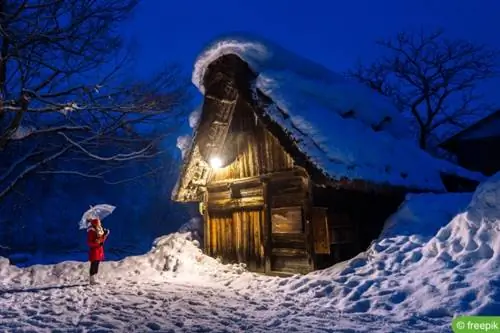
Heating
There are different ways to heat a lonely forest hut. If you get permission, you can install a fireplace and heat solely with wood. The advantage is the size of the hut. Since they are usually smaller, a fireplace is sufficient. Just make sure that the stove is not too large, is professionally installed and approved by a district chimney sweep. Other ways to heat a lonely cabin include the following:
- Heat pump and underfloor heating
- Convection heating
- Fan heater
Although these require a lot of power, they are effective in performance. However, due to the high electricity consumption, they are only suitable for properties with developed access to electricity. Gas ovens are also available, but you must ensure that they are installed professionally so that there are no he alth risks. It is also possible to install a thermal solar system. You just have to make sure that there is enough sun available over the duration of use. This is the only way the system works effectively. On average, a heating output of 4 to 10 kW is required for a 30 square meter hut.
Wastewater
For a weekend property, there are two options for disposing of wastewater:
- Access to the sewer system
- drainless pit (septic tank)
If your property is developed, you don't have to worry about wastewater. The only important thing here is that you have the shower or washbasin, for example, connected professionally. If this is not possible, you will need a drainless pit. This fills up over time and then has to be emptied by a waste disposal company. Septic tanks for a weekend cabin should have at least five cubic meters of space per person.
Internet access
Internet access is not always necessary if you want to switch off for two to three days. However, it's not a bad idea to be able to let family and friends know if something happens. Most weekend home areas do not have an internet connection, but can be reached via mobile internet. All you need is a SIM card, which is inserted into either a mobile internet modem, your tablet or smartphone. You can then book a flat rate or use your prepaid credit. Mobile Internet is particularly suitable for quick checks of your emails or instant messengers.
Far from civilization
Lonely huts can be an interesting target for possible burglars or even wild animals because they are often left unused for weeks. To avoid this problem, there are various ways to secure your own weekend home:

Castles at the hut
Locks are essential to make a weekend home as secure as possible. Equip doors and windows with locks to prevent burglars from entering your cabin. For doors, use a combination of cylinder locks and striking plates. Ideally it is a solid wood or fiberglass door so that it cannot be broken open easily. Windows are locked with crossbars or bar locks. This means that a large proportion of possible thefts can be prevented.
Enclosure
Fences, hedges or walls increase the security of your hut many times over. The best thing is, you can decide the design of the enclosure yourself and adapt it according to the cabin.
Surveillance cameras
Modern surveillance cameras have long-lasting batteries, can be equipped with memory cards of your choice and even enable a live image via apps if internet access is available. Surveillance cameras are also a great deterrent to burglars because they can be recorded. Alternatively, you can use dummies. At first glance they look like a real camera, which is enough of a deterrent. Models with motion detectors even send you push notifications to alert you to a possible break-in. This greatly increases the safety of huts that are not used for months.
Window Covers
Curtains, blinds and curtains help prevent potential burglars from having access to the contents of your hut. If what's in your weekend house isn't visible from the outside, it's not worth the effort for many potential burglars. It could be an empty house that only stores a few garden equipment.
Parking Security
This point is primarily related to tiny houses that are fixed to a trailer. Use parking claws to permanently secure the trailer. This will prevent the entire house from simply being driven away.
Note:
If you prefer permanent surveillance of your weekend home, you can hire a security company. They equip the cabin with adequate security systems and check the property at regular intervals.
Keyword facility
Once the hut is ready and the essentials have been taken care of, it is now the turn of the furnishings. From this point on you have almost made it and can soon retire to your little “home”.
Basic equipment of the hut
When choosing the right furnishings for your weekend home, you should pay particular attention to one sentence: less is more. Since the cabin is designed for a vacation or weekend trip, basic equipment is sufficient. The following are particularly important:
- Toilet and shower cubicle
- Sink or sink
- Lighting (either installed or mobile)
- Cooking option
- Mini fridge or freezer
- Sleeping options (bed, hammock or sofa)
- Dining or coffee table (depending on family size)
- Seating as required
- Cabinets, boxes and other storage options
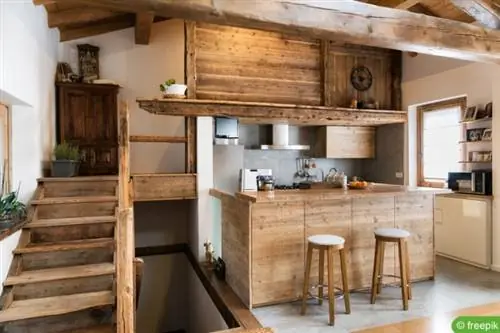
With these basics alone, you can enjoy shorter to longer stays in your secluded cabin. Ideally, you should check in advance how much electricity the devices use in order to use the available energy efficiently. This is particularly important for refrigerators. Most properties do not allow human waste to be disposed of via sewage. For this reason, you should choose camping toilets that you can easily empty after or during your vacation. Electrically operated mini stoves or gas camping stoves are ideal for cooking. As a rule, they do not require a permanent installation. Alternatively, you could use a fireplace with an integrated stove if you want to keep your cabin warm with wood. Otherwise, you can theoretically set up the hut however you like.
Relaxation through renunciation
Don't do the following to really switch off:
- TVs
- Desktop PCs
- Game consoles
- large electrical appliances such as washing machines (generate a lot of noise)
- Hi-Fi systems
- Projector
- Smart Home Devices
A weekend house should relax and bring nature closer. In addition, the majority of these devices take up a lot of space that you can use for other furnishing elements.

Safety first
It is also advisable to ensure sufficient security. This does not mean burglary protection. Since forest huts are often a bit out of the way and emergency services take longer to reach them, you should have the necessary safety equipment. These include:
- First aid kit
- Fire extinguisher
- Fire and carbon monoxide detectors
Summary and Conclusion
It may not be possible in Germany to simply get out in a lonely hut like it would be possible in Alaska. But even if German building law in particular has created some hurdles here, it is still possible to fulfill your dream of such a drop-out hut - at least for occasional use. And by the way, in contrast to Alaska's wilderness, not being hundreds of kilometers away from the nearest person definitely has its advantages.

